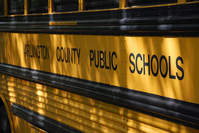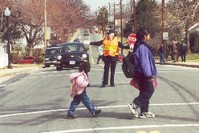Arlington Public Schools must think beyond buses

Photo by afagen on Flickr.
Arlington County residents rely more and more on a wide range of transportation choices to get around the county, but Arlington Public Schools (APS) still focuses solely on buses in its transportation plan. A recent controversy around which students could ride the buses exposed the weaknesses and omissions in APS’s transportation planning.
Current Arlington policy provides bus service for students living more than 1 mile from elementary school or 1½ mile from middle and high school. In-mid August, the school district sent letters to each family with APS students informing them that the school district would more rigorously enforce these “walk zones.”
The letters informed families whether their students were eligible and, if so, where their bus stop was. Because of this, many students who previously rode the bus were suddenly designated as walkers just as the school year was set to begin.
Parents were upset that the changes came without much notice. The process was a serious problem, and this episode also highlights how a singular focus on buses versus no buses doesn’t effectively serve all Arlington residents.
The APS transportation department website reveals almost no information beyond how the buses are operated and who is eligible to ride them. Even a document with the encouraging title of “Transportation Demand Management” is mostly about the parking at schools, and has only a short list of vague phrases about how to help students get to school any way other than driving or riding the school bus.
These statements and documents reveal that the transportation plan for APS is essentially a bus plan and little else. In the 21st century, a mid-20th century school bus plan is insufficient. A good transportation plan should address the transportation system as a whole and every student’s transportation mode, whether it’s bus, bike, skateboard, car, or shoes.
It should also address issues of traffic, environment, and even land use. A comprehensive plan should look forward in time, set goals, and put in place strategies to meet those goals. If it proposes changes, it should look at the effects of those changes on traffic, environment, timing, and safety.
Those are all things that the Arlington government (as distinct from the schools) has decades of experience with. Arlington’s transportation department is often held up as a national model for how jurisdictions should develop and implement long-term transportation plans. At least 40 years ago, the county was already planning for transportation and land use in the Rosslyn-Ballston corridor.
Arlington has effectively managed enormous growth in commercial development and multi-family residential development with virtually no increase in traffic for several decades. Now, similarly, the schools are experiencing rapid growth in student population and APS needs to plan for that growth to continue. It’s time for APS to call Arlington’s transportation department and request their expertise in developing a real, 21st-century transportation plan.

